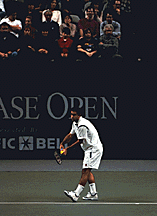The McEnroe Serve
By John Yandell
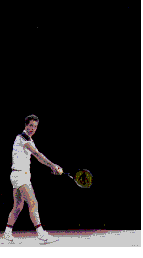 |
Most players who remember John McEnroe's serve recall his distinctive sideways starting stance, with both feet along the baseline, and the slow rhythmic rocking motion at the start of his delivery.
McEnroe's sideways stance broke new biomechanical ground in tennis allowing him to generate roughly twice the body rotation of players with conventional motions (close to a full 180 degrees, compared to the 90 degrees in a conventional motion).
You can see the extent of the rotation by comparing McEnroe's shoulder position in the two photos at the left.
The influence McEnroe had on serving in the modern game is evident today in the motion of players like Pete Sampras. Although his stance is less extreme, Sampras lines up his feet with the back foot behind and to the left of the front foot, with the toe turned back even further away from the baseline, or slightly open.
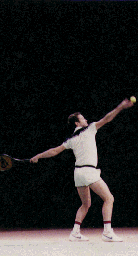 |
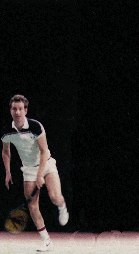 |
|
The result is that as he begins his wind up, his body naturally turns away from the net. Prior to rotating into the delivery, his back is approaching parallel to the baseline. A significant increase in power is generated as he comes to the ball.
There is no doubt that the tremendous hip and shoulder torque pioneered by John McEnroe can be a key power source in any service motion. Advanced players looking for more power should consider experimenting with the starting stance and its effect on the body's rotation.
For the average player, however, there are several far more important lessons in studying the motion of this great serve and volley champion.
Eliminating the advanced starting stance, the other core elements in McEnroe's motion are among the most classical in tennis history. His basic motion forms a perfect model for the average player to study and emulate--before experimenting with the advanced biomechanics of increased torso rotation.
In developing each of these key positions, create an internal mental image of how the position should look inside your mind's eye and especially how it feels. Then visualize the entire motion, with your body and racquet passing through each key frame when you actually serve.
 |
1. Wind Up:
The photo shows the ideal arm and racquet position for any player to emulate in developing a smooth, relaxed wind up. Note the the arm and racquet point straight back, with the racquet face perpendicular to the court surface. Many players begin bending the elbow too soon and try to muscle the racquet through the motion. Passing through this position will help you keep it loose and unhurried.
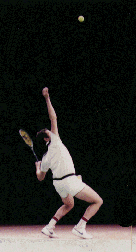 |
2. Coiling of the Legs:
The effective use of the legs is probably the most misunderstood element in serving technique among recreational players. In pro tennis it is one of the few technical elements that is virtually identical among all the top players. McEnroe is a textbook example. Note the tremendous knee bend in the photo. The weight has shifted to the front leg, and the quadriceps is fully coiled. Now as the motion continues, the knees naturally uncoil, propelling McEnroe upward into the ball, generating tremendous additional force.
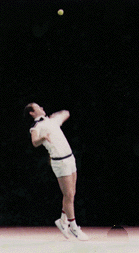 |
3. Complete Racquet Drop:
Note the elbow position in this photo. The smooth wind up leads to a full racquet drop, with the elbow at about 45 degrees to the court surface. At this point John's racquet is pointing directly down at the court. The racquet drop is the number one power source on the serve. If possible, video your motion from behind and check yours. Until you've developed a complete drop, trying to generate extra power from other parts of the motion is wasted effort.
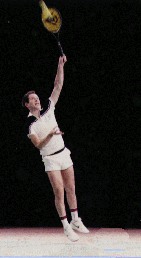 |
4. Contact at Extension:
Here John displays perfect "tip to tip" extension. From the tip of his toes to the tip of his racquet his reach to the ball at the contact point is maximized. This provides additional net clearance, ball trajectory, and effortless power. Note also the beautiful upright body position, with his torso almost perfectly straight up and down from the waist. Even some of the very top players tend to bend at the waist, either forward, to the side, or both. John's body position here is as good as anyone in the history of the game. This leads to consistency and accuracy, two trademarks of John's serve over the years.
 |
5. Full Follow-Through:
Here we can see the smooth, complete finish of the motion across the body with the racquet hand in front of the opposite leg. John lands on his front foot, already 3-4 feet inside the court - the back leg is still behind him and in the air. Only after the motion is completed in this position would he take his first step to the net. One of the common mistakes in recreational play is to try to step through the motion with the rear foot in the mistaken belief this will add power and get the player to the net sooner.
Properly executed, the service motion is the most relaxed of all the strokes, with the least amount of muscle contraction. This generates racquet head speed. Far too many players at lower levels tense up in an attempt to muscle the ball. This reduces racquet speed and leads to injuries. Key your motion on the image of the racquet hand staying soft and reaching all the way across to the opposite leg.
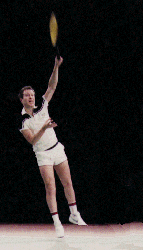 |
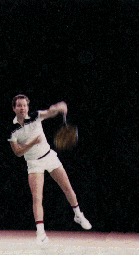 |
Note in these two photos how the back foot actually kicks back away from the body after contact.
In effect, the back leg becomes a counterweight, maintaining John's upright body position and balance.
Not every player possesses the phenomenal leg strength to bend as deeply as McEnroe, but this coiling, combined with a balanced landing on the front foot is actually easy to master and will increase the velocity of most serves by up to 25 percent.



